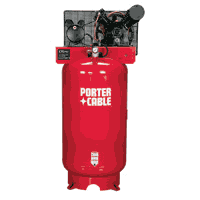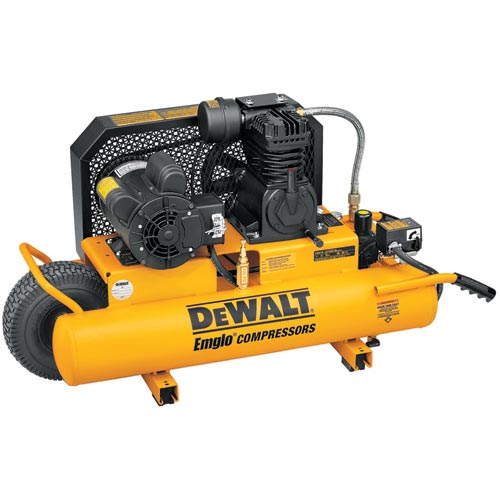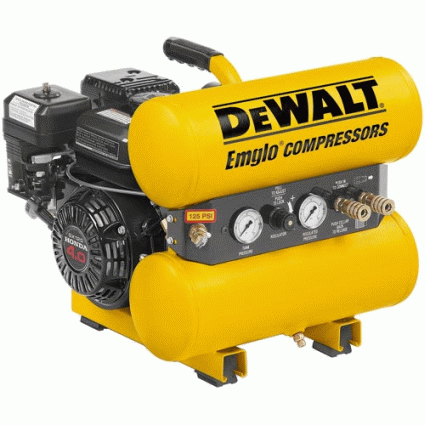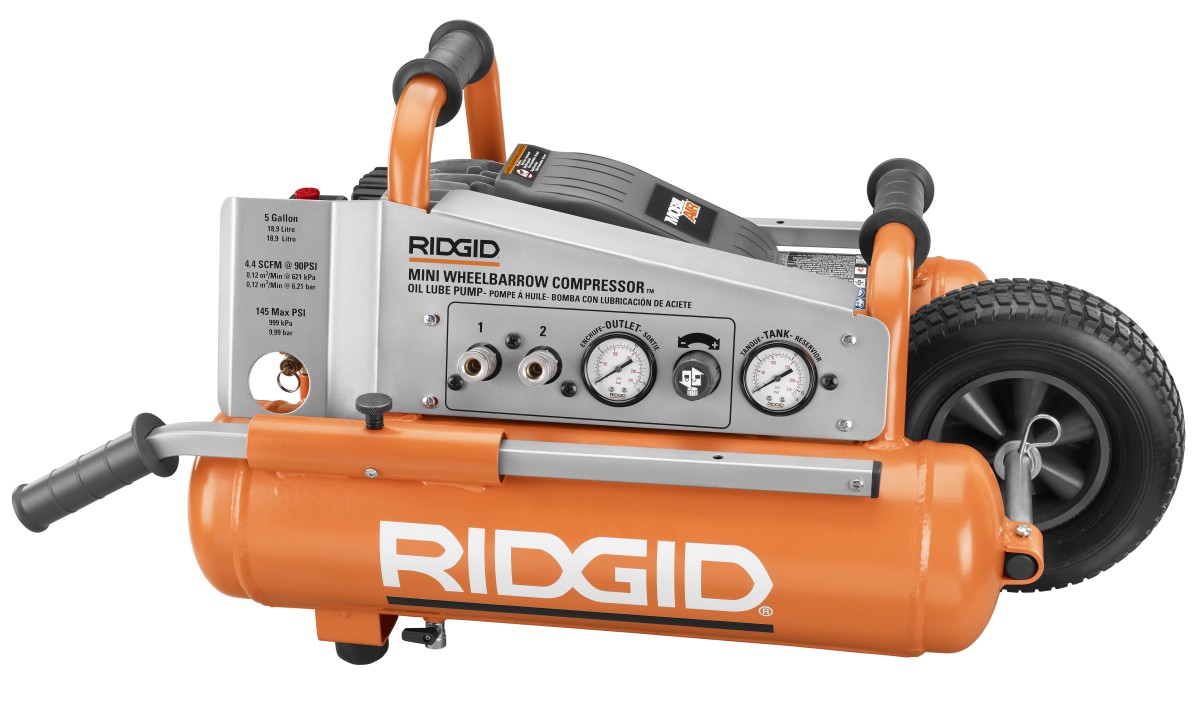Why Read This Article?
Finish Nailer Repair - Replacing the Driver Guide (Ridgid Part # 79004001022)
Article Breakdown
Finish Nailer Repair - Replacing the Driver Guide (Ridgid Part # 79004001022)
Safety Guidelines
- Check the compressor's valve safety often and make sure that it is working correctly.
- Only operate air compressors in areas with good ventilation, especially when painting or spraying other flammables into the air.
- Always keep flammable materials away from air compressors while in operation.
- Drain compressor air tanks after each use and replace cracked or leaking reciever tanks with a new tank immediately.
- Never operate air compressors in rainy or other wet conditions.
- Using extension cords with electric compressors can be dangerous. Run a longer air hose to close the distance between the air compressor and the work area.
- Read the instructions manuals for air compressors and follow all other safety recommendations and guidelines.

Air compressors pull regular air into their cylinders at atmospheric pressure (like drawing a breath into your lungs). But once the air is in the cylinder, it is immediately compressed by a piston (or pistons) in a compression chamber to the desired, higher pressure. This process of compressing the air creates heat, because of the increase of air friction.
After being compressed, the air must be cooled by the compressor's cooler (sometimes called an aftercooler, or radiator), which removes some of the heat caused by compression.
From the aftercooler, the compressed, cooled air is passed into the compressor's tank, or receiver tank to be stored until it's used.
Receiver tanks come in many sizes (depending on the demands of the job). The compressed air is stored up to make sure that the air pressure leaving the tank is as consistent as possible. Most pneumatic tools (air tools) will demand different levels of performance from an air compressor at different times during use. Storing a large volume of compressed air in the receiver tank smooths out the peaks and valleys of the tool's demand. A pressure switch helps the compressor maintain constant air pressure as the air leaves the hose.
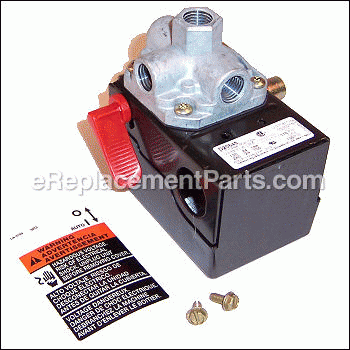
A Pressure Switch
(Hint: This is especially important when air compressors are being used for painting (for example), since a drop in pressure could foul up the paint job.)
The compressor's pressure switch controls the amount of compressed air stored in the receiver tank.
Cooled and compressed air is added to the receiver tank until the tank reaches its maximum pressure, at which point the compressor stops compressing air. Some compressors completely shut off during this phase.
The compressor will start compressing air again when the pressure in its tank drops below its preset minimum pressure. Maximum pressure and minimum pressure are sometimes called the cut-out pressure and cut-in pressure.
The compressed air then leaves the receiver tank through the compressor's air hose, and exits the system through the air tool or air chuck. A regulator on the compressor is used to set the pressure of the air leaving the compressor. Pressure should be set to match the requirements of the tool(s) being used.
Because water and moisture can be hard on tools and tool parts, some compressors are equipped with in-line air dryers, and many compressors can be upgraded to include dryers. These dryers take the water out of the compressed air as it leaves the tank, before the air is passed to the air hose. This is especially true of large, industrial-sized air compressors and compressors used for painting (to keep water out of the paint mixture).
Compressors also have a valve safety, used for releasing pressure from the tank in an emergency, or simply to empty the tank of air.
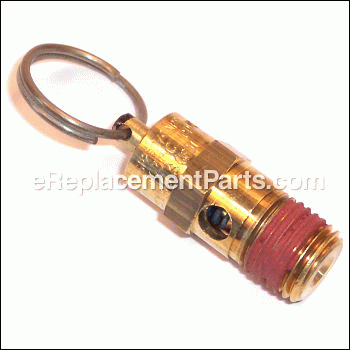
A Valve Safety
And that's it! Now for a recap:
1. Air compressors draw in regular air and pressurize it with a piston.
2. Compressed air in the compression cylinder is hot and must be cooled with an aftercooler.
3. The compressed and cooled air is stored in a receiver tank.
4. A pressure switch keeps the pressure the same as the air leaves the compressor.
5. A regulator is used to adjust the pressure setting of the compressor.
6. The pressurized air is often dried with an air dryer of some kind before it leaves the compressor and enters the tool.
[Back to top]
A Couple Technical Things
There are a few variations when it comes to air compressor design. Most of these differences are more-or-less unimportant for most air compressor users, but we'll mention one here that's worth mentioning.
Some air compressors are built with their motor shafts directly connected to their compression cylinders. These are called direct coupled units. Others are built so that the motor shaft drives a belt which in turn drives the compressor, and are called belt driven units.
Most reviews and opinions lean toward belt driven air compressors, because they tend to be more quiet and efficient at higher motor speeds.
Here are just a few terms you might run into when shopping for or reading about air compressors:
air pressure range- for air tools, this is the pressure range at which they should be used. Example: The air pressure range for a Porter-Cable FN250B Air Nailer is 70 psi to 120 psi.
CFM/SCFM- Cubic Feet per Minute/Standard Cubic Feet per Minute. These terms can refer to at least two things when it comes to air compressors:
1. the volume of air that an air compressor delivers over time (minutes), and
2. the volume of air that an air tool consumes when in use (its demand).
The "Standard" in SCFM refers to standard conditions of atmospheric pressure, temperature, and humidity at which tools are sometimes tested, but either term can be used for most purposes.
For air compressors, CFM is displayed along with pressure (psi) because the volume of air being delivered depends on the pressure it is being released at. Increasing the air pressure usually means that less air will be delivered, or less CFM.
Example: The Porter-Cable C2002 Air Compressor specs at 3.7 CFM @ 40 psi for normal operation, and 2.6 CFM @ 90 psi for better recovery time.
duty cycle- for air compressors that need a rest period between working, duty cycle refers to the amount of time that an air compressor needs to rest and is usually written as a percentage. [Back to top] Types of Air Compressors Strap yourself in, because air compressors differ in many ways depending on job demands. Deciding between each option below is a matter of looking at needs, the tools being used, how many users, and budget. The major differences between air compressors are listed and explained below in terms of options, pros, and cons. Mounted/Unmounted Options The first major difference between air compressors is mobility, so, naturally, you have a choice between portable air compressors and permanent mount air compressors. But be careful, because there are major differences when it comes to the pros and cons of each. The type of place where the air compressor is needed will often do the deciding for you.
Permanent Mount:
The best use for mounted air compressors is obvious. Mounted compressors are typically for permanent shops, for working out of a truck, and for longer-term job sites.
Most mounted compressors are electrically powered, but mounted, gas-powered compressors can be found for trucks and job sites as well.
Pros: Permanent mount compressors aren't portable, but their list of advantages is long.
- they tend to be less expensive
- upgrading permanent mount compressors with air filters, water filters, and in-line lubrication is easier.
- there is a much broader selection of electrical power options for mounted units.
- generally, they are more powerful.
- generally, they have greater air capacity (CFM output).
Cons: Unless you absolutely need a portable compressor, choosing a permanent mount is usually best.
- not portable.
- more air hose must be run when distance is an issue, and that means some additional cost.
Permanent Mount Example: The Porter Cable C7580
Portable:
As expected, the real advantage to portable air compressors is their portability. The good news is that portable compressors are versatile, and most jobs that need air compression can be handled just fine by fairly-priced, portable units.
Pros and cons for portable compressors are the reverse of the pros and cons for mounted compressors.
Pros: There's really no replacement for mobility when you have to have it, and that's where portable compressors shine.
- portability and versatility.
- no additional air hose needed.
Cons: Getting mobility from a compressor is a trade-off, but, as mentioned before, this list of cons isn't an issue for most jobs.
[Back to top] Stage Options Air compressors are designed with one or more "stages" (cylinders) where the pistons compress the air.
- they tend to be more expensive (the biggest drawback).
- upgrading for filtering and lubrication is more difficult, but usually not needed for jobs where portable units are used.
- most portable units are designed to be electrically powered by standard wall current (but, again, that's usually plenty for mobile projects).
- air capacity (CFM output) and overall power tend to be less.
- high powered portable units are available, but they are almost always gas-powered, heavy, and expensive.
- The general idea is that if you don't need a portable unit, buy a permanent mount compressor.
- But when mobility is a must, finding a good portable air compressor at a decent price shouldn't be hard.
Portable Compressor Example: The DeWALT D55580 Portable Compressor
Single stage:
Single stage compressors are like those described in "The Basics" section of this article. The "single" in "single stage" means that they only have one cylinder for compressing air. For most air tool jobs (requiring 120 psi or less), especially jobs around the house, single stage air compressors perform nicely.
Multistage:
For pneumatic tools and jobs that need more pressure (above 120 psi, generally), multistage compressors measure up to meet the demand. Multistage compressors have two or more cylinders. After air is compressed in the first cylinder, it is passed to the second cylinder for more compression, and so forth.
Multistage compressors create much more heat than single stage compressors, and usually require a radiator. They are needed most when more than one person will be using the same air compressor, and when high demand air tools are in use. Examples: grinders, air nailers, air sanders, and tire changers.
Pros/Cons: The pros and cons for these options are simple. As the air pressure (stages) and power increase, so do power requirements, cooling requirements, cost, and weight.
Bigger more powerful machines weigh more, need more cooling, cost more, and need more power. The opposite is true of smaller, single stage machines.
If you need a multistage compressor, you'll know by the tools you plan to use with it and how many people will be using it at once.. If you're not sure if a multistage compressor is for you, giving one a "test lift" will usually provide all the missing information you need (make sure to "bend the knees").
[Back to top]
Power Options
Choosing between a gasoline or electric air compressor can be made easier by making other choices first, like choosing portable or mounted. Considering both mobility needs and the demands of the job usually narrow the choice down.
Other considerations play a part as well, such as what type of tools will be used, air pressure needed, and number of users.
Gasoline:
Most gasoline compressors are portable, but mounted gasoline-powered compressors for trucks and job sites are available too. There are two basic kinds of gasoline compressor motor designs. Some power electric generators which then drive the cylinder(s) with an electric motor. Others drive their cylinder(s) directly, using a clutch.
If you need a multistage compressor (portable or mounted) it will probably have to be a gasoline unit to meet the power demand. Portable compressors grow heavier with increased power performance. This is especially true since gas compressors tend to be heavier anyway. Portable, multistage, gas-powered compressors can easily grow to be monsters in the 200 lb.+ range.
The real benefit that gasoline compressors offer is an alternate fuel source when electricity isn't an option. That usually means the work site is remote, so the extra noise they make usually isn't usually a problem.
Pros: Gas compressors are a great option when electricity isn't available or if portability is an issue.
- alternate source of power.
- usability in remote areas.
- power, in the case of high performance portable machines.
Cons: These could be a problem if you don't really need a gas compressor, but the extra hassle pays for itself quickly if it fits your needs.
- hassle of buying, transporting, and keeping gasoline on hand.
- they tend to be more noisy.
- powerful, multistage portable units must be gas powered and are heavy.
- a little extra maintenance if you choose to clean the gas tank now and then. Gas Compressor Example: The DeWALT D55250 Gas Compressor
Electric:
Easy, convenient, and the most common way to run a compressor. Most operate on standard wall current, but the bigger, powerful models offer additional higher-voltage power options. This way, the mounted electric units can keep up with the performance of the powerful portable units, and then some.
Choosing the right electric compressor is very important. As with gas compressors, undershooting your performance needs with an electric compressor will have you replacing your weaker unit in no time. But, if you overshoot on an electrical unit, you may end up paying way more for your power bill than you'd like.
Electric compressors are best for most users when the right one is selected. There are some portable electric units which are best when you need a compact model. One of the biggest drawbacks is having to run lots of air hose, since using extension cords is not recommended (see below)
Pros: The benefits of electric compressors over gasoline are considerable unless electricity is not available.
- easy, hassle free power source.
- best choice for permanent mount compressors.
- best choice for most jobs
- portable units are more compact and weigh less.
Cons: These usually aren't a problem unless mobility or an alternate power source is needed.
Like the other options discussed here, the best course of action is to examine your needs. A lot of choices make themselves if you can really pin your needs down first.
- additional cost to run extra air hose is recommended to reach a work area, not extension cords.
- powerful electric units require heavy duty electrical wiring to meet power needs.
- portable units are less powerful than gas compressors.
- powerful units can have expensive energy demands.
Electric Compressor Example: The Ridgid OL50145MW Electric Compressor
Bonus Power Option!: Yes, natural gas powered air compressors are available. These are BIG industrial sized units. Genuine need or want for this kind of compressor is seldom, so, if you're curious, this website might be a good place to start: https://www.aircompressor.org/
Natural gas compressors attract the attention of manufacturing plants and the like, because they can reduce a plant's power bill when compared to large electric compressors. [Back to top] Lubrication Options This might be the easiest decision to make when buying a compressor. Oiled compressors outperform and outlast oil-less compressors at the expense of extra care and maintenance. If your compressor is going to see a lot of use, oiled compressors are a must, and the required maintenance will be worth the effort in every way. Oil-less compressors are only recommended if you're planning to use your compressor now and then. If that's the case, an oil-less compressor will perform well for a long time without extra care.
Oiled:
In an oiled compressor, the cylinders are thinly coated with oil as the machine operates. This makes them much more durable. This also means that, like a car or lawnmower, that the oil must be changed from time to time. Also, oil compressors cost more than oil-less compressors, but it's almost always worth it to go with oil.
Buy an oil compressor if it's going to see a lot of use. Oiled models are absolutely necessary for high power compressors, because a tighter cylinder seal is needed as pressure increases (even more so for multistage compressors).
Checking the oil level with each use and scheduled oil changes are strongly recommended, because an oil compressor will outlast oil-less models by a long shot if cared for correctly.
Pros: These advantages of oiled air compressors heavily outweigh the slight inconvenience of the extra care involved.
- oiled designs make powerful compressors possible.
- oiled compressors last longer.
- oiled helps cool the unit.
- oiled compressors are best under all circumstances, except in the cases of occasional use and budget limits.
Cons: Don't let these cons scare you into buying oil-less unless you really don't see yourself using your compressor much.
- extra care and maintenance with oil changes/checks.
- oiled units weigh more in general.
- oiled units are heavier in general.
- oiled units are more expensive in general (but they're most always worth it).
Oil-less:
These compressors are "permanently" lubricated, usually by coating the the cylinders with something like teflon. You might hear that oil-less models are more advanced. They cut down on care and hassle at first, yes, but the fact is that they wear out, and having to buy a new one is a big hassle. There's just not a good substitute for doing it the old-fashioned way.
But, if you just need an air compressor for jobs here and there that won't demand a lot of pressure (up to about 120 psi), oil-less might be just the thing for you. They are less expensive (because it takes fewer parts to make them), and they are lighter (from having fewer parts).
Big heads up though--on average, oil-less compressors are not built as well as oiled compressors, but there are a few notably good oil-less designs here and there. So if lighter use is what you're looking for, then an oil-less compressor could be the perfect buy.
Pros: Don't let the flashy prices or advertising twist your arm into buying an oil-less design unless you're sure it won't see heavy use.
- less expensive.
- oil-less machines are lighter.
- convenience. Oil-less machines don't need the maintenance that oiled machines do.
Cons: Also, don't let the cons scare you away if an oil-less compressor fits the bill (occasional use).
That's all a pretty big mouthful. There's always more to know on any subject, but those are the basic types of air compressors. Most importantly, the information above covers most bases for estimating your air compression needs. When you can do that, you're well on your way to finding the right tool. [Back to top] Purchasing Guidelines for Air Compressors There are still a few things to go over that are important when shopping for an air compressor. Can't say it enough...estimate your needs carefully. The information above covers a lot of bases, but here's a few more pointers:
- less durable, because the "permanent" lubrication eventually wears down.
- oil-less compressors run hotter.
- oil-less units have a power cap, and generally are not as efficient as oiled compressors.
- oil-less air compressors only offer a good return on their purchase value if you don't plan to use it heavily.
- Find out the psi requirements of the air tools you plan to use. In the end, you want to overshoot your CFM needs. If you plan to use more than one tool at a time on a single compressor, add those requirements up.
- Most air compressor reviews and suggestions say to add on about 25% to your CFM needs.
- Overshooting and spending a little more is much better than undershooting and replacing a new compressor. Just be careful with those big electrical units, because overshooting too much can easily inflate a power bill.
- Advertising can be misleading. Focusing on the specifications is the way to go.
- Making a purchase decision on just one spec (like horsepower or CFM rating) will not guarantee that you find a compressor that performs well.
- Weighing your air tool needs (CFM, psi, number of users, etc.) against a combination of specification factors is the way to go. Striking a balance between CFM @ psi, size of the receiver tank, and horsepower will tell you a lot about the actual performance of the compressor you are looking at.
- Many machines might shine in say, horsepower for example, but wimp out in other areas.
- Budget. Simply get the best machine that you can afford. A well-chosen compressor will save you money in the end.
- Last, find out as much as possible. Your situation might be completely unique and could bring up questions that the information in a "101" article doesn't answer.
There is tons of information out there, and the more you know the better. Searching for product reviews, consumer reviews, specific issues, and even asking people you trust will go a long way. [Back to top] Care and Maintenance for Air Compressors
Changing Oil:
- For oiled air compressors, changing the oil is as important as any oiled machine.
- How often you have to change the oil depends on the the machine that you have. Sometimes the recommendation is a time period, like 2 months, and sometimes it hinges on hours of use (Example: 200 hours).
Every Use
Checks:
- Most machines come with the recommendation of checking oil levels often, or with every use.
- Checking the valve safety for safe operation is recommended before each use.
Occasional
Checks:
- Checking a compressor unit often for air and moisture leaks will help catch problems before they start costing time and money.
- Gas tanks can be cleaned from time to time to keep a gasoline compressor's performance up.
- Air hoses and power cords should be checked for kinks, wear or leaks.
Cords:
Following any other suggestions from instruction and user manuals is always a smart way to extend any tool's life and increase its value. [Back to top] Purchasing Examples Example #1:
- Extension cords should only be used for electric air compressors if you make them yourself out of thick, flexible, very well insulated wire. You should only attempt this if you have done it before, or if you have the help of someone who has.
- Standard extension cords just won't cut it, and using them could result in damage to the cord, the compressor, or an electrical fire. It's just not safe.
- These hazards are why running more air hose is always recommended.
I'm looking for the right air compressor to run a Porter-Cable FN250B Air Nailer. I'm planning to use my nailer only occasionally, and it is the only tool for which I need a compressor. I also need my compressor to be portable, but I plan to always have access to electricity, and distance to the work area will not be a problem.
- First, I'll find out the tool's specifications. The Porter-Cable FN250B Air Nailer operates between 70 psi and 120 psi, and has a CFM demand of about 2.2 SCFM.
1. I'll use the 25% rule of thumb for the CFM demand of the tool to make sure I get a compressor that can keep up. In this case: 2.2 SCFM x 1.25 = 2.75 SCFM
- I need a compressor that can provide about 2.75 CFM @ 120 psi for this tool. Note: The 25% rule of thumb is a little generous. Each situation will be a little different, but it is a good place to start.
2. I already know that I need a portable compressor.
3. Because I plan to have only one user on this compressor, and because I only need up to 120 psi for the air nailer, a single-stage compressor is enough for this job. A multistage compressor would be over-doing it. Also, a portable multistage compressor would be heavier.
4. I could take my pick between gasoline or electric for this example, but I will choose electric, because it is more convenient, I will have access to it, and it will be a short distance between my compressor and the work area.
5. I could choose an oiled air compressor for this example if I was extra concerned about the machine lasting and didn't mind the maintenance. But it looks like an oil-less design will fit my needs fine, since I'm planning to use the compressor occasionally. This will make my compressor even lighter, more compact, and less expensive. Also, there are plenty of oil-less designs that can keep up with my tool's requirements. Decision: For this example, I choose a portable, single-stage, electric, oil-less air compressor that can deliver around 2.75 CFM @ 120 psi. Models That Match:
Hitachi EC79 Oil Free 6 Gallon Pancake Air Compressor
Makita MAC500 1.5 HP Air Compressor
Example #2:
I'm looking for a compressor that can run two Porter-Cable FN250B Air Nailers in my shop. This compressor will see almost constant, daily use. I have the necessary wiring to run bigger machines and plenty of extra air hose ready for installation.
- First, I'll find out the tool's specifications. The Porter-Cable FN250B Air Nailer operates between 70 psi and 120 psi and has a CFM demand of about 2.2 SCFM.
1. I'll use the 25% rule of thumb for the CFM demand of the tool to make sure I get a compressor that can keep up.
- Remember, I'm dealing with more than one tool on the same compressor in this example. I will need to add up their SCFM requirements.
In this case: 2.2 + 2.2 SCFM x 1.25 = 5.5 SCFM
- I need a compressor that can provide about 5.5 CFM @ 120 psi for these tools. Note: The 25% rule of thumb is rather generous. Each situation will be a little different, but it is a good place to start.
2. I don't need a portable compressor, so I choose a permanent mount compressor.
3. A multistage compressor will be my best choice, because I will have more than one user on the compressor at a time. Some single stage compressors may be able to handle the demand of two air nailers. (Hint: Having more than one user on a compressor is also a good time to think about buying a compressor with a larger receiver tank.)
4. I'm ready with the right wiring for a larger compressor, so the power of aa gasoline compressor isn't necessary. I will choose an electric compressor. I also have plenty of air hose.
5. I need a compressor for heavy, daily, long-term use. I will choose an oiled compressor for sure. The extra maintenance is worth it in my case. Decision: For this example, I choose a permanent mount, multistage, electric, oiled air compressor that can deliver around 5.5 CFM @ 120 psi. Models That Match: Porter Cable CPLC7060V Type 0 Stationary Vertical Air Compressor [Back to top] Conclusion Knowing how air compressors work is the first step toward a good buy. There are a lot of things to consider when choosing between different types and features of air compressors, but taking a close look at each option and matching each choice to your needs will clear the fog and help to zero in on the perfect model. The best result for any air compressor or tool buyer is the same: increasing the value of the purchase. Getting more out of an air compressor is as simple as being informed, estimating your needs, and giving it the right care. eReplacementParts.com carries thousands of air compressor parts for top compressor brands. Browse our Air Compressors page to view compressor model breakdown diagrams and find needed repair parts. Our services are here to help our customer's compressors, tools, and other machines live a full, quality performance life. [Back to top] What we're about.


















































